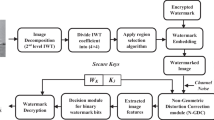Abstract
In this paper, a new methodology for the secure embedding of data in a video sequence is presented. To guarantee the imperceptibility of the embedded data, we propose a novel method for selecting the frame regions that may be considered perceptually non relevant. For each frame of the video, a saliency analysis is performed based on features that are thought to be relevant to the Human Vision System. In particular, the local contrast, the color, and the motion information have been considered. By weighting all these features, an importance map is built to drive the embedding procedure. Subjective experiment results show that the artifacts caused by this localized embedding procedure are considered by the subjects to be less annoying than if the data hiding is performed on the whole frame. Nevertheless robustness is achieved.
Similar content being viewed by others
References
J.-L.D.G. Doërr, A guided tour to video watermarking, Sig. Proc.: Image Comm. 18 (2003) 263–282.
K.S.D. Kundur and D. Hatzinakos, Digital video watermarking: Techniques, technology and trends, in: H.-C. H. P.J.-S. Pan and e. L. Jain (Eds.) Intelligent Watermarking Techniques, (World Scientific Publishing Company, 2004) Chapter 10, pp. 265–314.
M. Moore, Psychophysical measurement and prediction of digital video quality, Ph.D. dissertation, University of California Santa Barbara, June 2002.
A.M.W. Osberger, Automatic identification of perceptually important regions in a image, in: International Conference on Pattern Recognition (Brisbane, Australia, 1998).
A.J.R.W. Osberger, Automatic detection of regions of interest in complex video sequences, in: SPIE—Human Vision and Electronic Imaging VI (Bellingham, USA, 2001), Vol., 4299 pp. 361–372.
Z.Y. Dong Tian and L. Shen, Motion activity based wireless video quality perceptual metric, in: International Symposium on Intelligent Multimedia, video and Speech Processing (Hong Kong, May 2–4 2001) pp. 527–530.
L. Karam, An analysis/synthesis model for the human visual based on subspace decomposition and multirate filter bank theory, in: IEEE Int. Symp. Time-Frequency Time-Scale Analysis (October 1992), pp. 559–562.
S. Marcelja, Mathematical description of the responses of simple cortical cells, in: J. Opt. Soc. Amer., 70 (1980) 1297–1300.
A.B. Watson, The cortex transform: Rapid computation of simulated neural images, Comput. Vis., Graph., Image Process. 39 (1987) 311–327.
N. Graham, Neurophysiology and psychophysics, Visual Pattern Analyzers, (Academic, New York, 1989), Chap. 1, pp. 3–34.
S.A. Klein and D.N. Levi, Hyperacuity thresholds of 1 sec: Theoretical predictions and empirical validation, J. Opt. Soc. Amer. 2 (1985) 1170–1190.
A.A. H.A. Peterson and A. Watson, An improved detection model for dct coefficient quantization, Human Vision, Visual Processing, Display VI: SPIE (1993) 191–201.
A.A. J.A. Solomon and A. Watson, Visibility of dct basis functions: Effects of contrast masking, in: Data Compression Conference (1994), pp. 361–370.
A. Watson, Dctune: A technique for visual optimization of dct quantization matrices for individual images, in: Soc. Information Display Dig. Tech. Papers XXIV (1993), pp. 946–949.
A.B. Watson, Dct quantization matrices visually optimized for individual images, in: B.E. Rogowitz (Ed.), Proc. Human Vision, Visual Processing, Digital Display IV (1993), pp. 202–216.
A.B. Watson, Visually optimal dct quantization matrices for individual images, in: Proc. Data Compression Conf. (1993), pp. 178–187.
A. Watson, Probability summation over time.
J. Robson and N. Graham, Probability summation and regional variation in contrast sensitivity across the visual field.
J. M. Foley, Human luminance pattern vision mechanisms: Masking experiments require a new model, Journal of the Optical Society of America A, Vol. 11 (1994), pp. 1710–1719.
J. Malo, I. Epifanio, R. Navarro and E.P. Simoncelli, Non-Linear Image Representation for Efficient Perceptual Coding, IEEE Transactions On Image Processing, (preprint).
A.B. Watson and J.A. Solomon, A model of visual contrast gain control and pattern masking, Journal of the Optical Society A, 14 (1997), 2379–2391.
M.M. S.M.-M. T.P. S. Pereira and S. Voloshynovskiy, Second generation benchmarking and application oriented evaluation, in: Proc. Information Hiding Workshop (Pittsburgh, PA, USA, April 2001).
S. Daly, Engineering observations from spatiovelocity and spatiotemporal visual models, in: SPIE—Human Vision and Electronic Imaging III, (Bellingham, USA, 1998) vol. 3299 pp. 180–191.
A. Neri, P. Campisi, M. Carli and E. Drelie Gelasca, Watermark hiding in video sequences, in: IEEE International Workshop on Video Processing and Quality Metrics for Consumer Electronics, (Scottsdale, Arizona,USA, January 2005) January 2005, Scottsdale, Arizona, USA.
25. C. Tomasi and T. Kanade, Detection and tracking of point features. Tech. Rept. CMU-CS-91132. Carnegie Mellon University School of Computer Science, Pittsburgh (1991).
T.K.B.D. Lucas, An iterative image registration technique with an application to stereo vision, in: Proceedings of the 7th International Joint Conference on Artificial Intelligence (Vancouver, 1981) pp. 674–679.
T. Takeuchi, K. K De Valois and J.L. Hardy, The influence of color on the perception of luminance motion, Vision Research 43 (2003) 1159–1175.
I. Cox, J. Kilian, F. Leighton, and T. Shamoon, Secure spread spectrum watermarking for multimedia, IEEE Transaction on Image Processing 6(12), (1997).
Methodology for subjective assessment of the quality of television pictures, ITU Recommendation BT.500-8, Tech. Rep. (1998).
Author information
Authors and Affiliations
Corresponding author
Rights and permissions
About this article
Cite this article
Carli, M., Campisi, P. & Neri, A. Perceptual aspects in data hiding. Telecommun Syst 33, 117–129 (2006). https://doi.org/10.1007/s11235-006-9009-x
Published:
Issue Date:
DOI: https://doi.org/10.1007/s11235-006-9009-x




